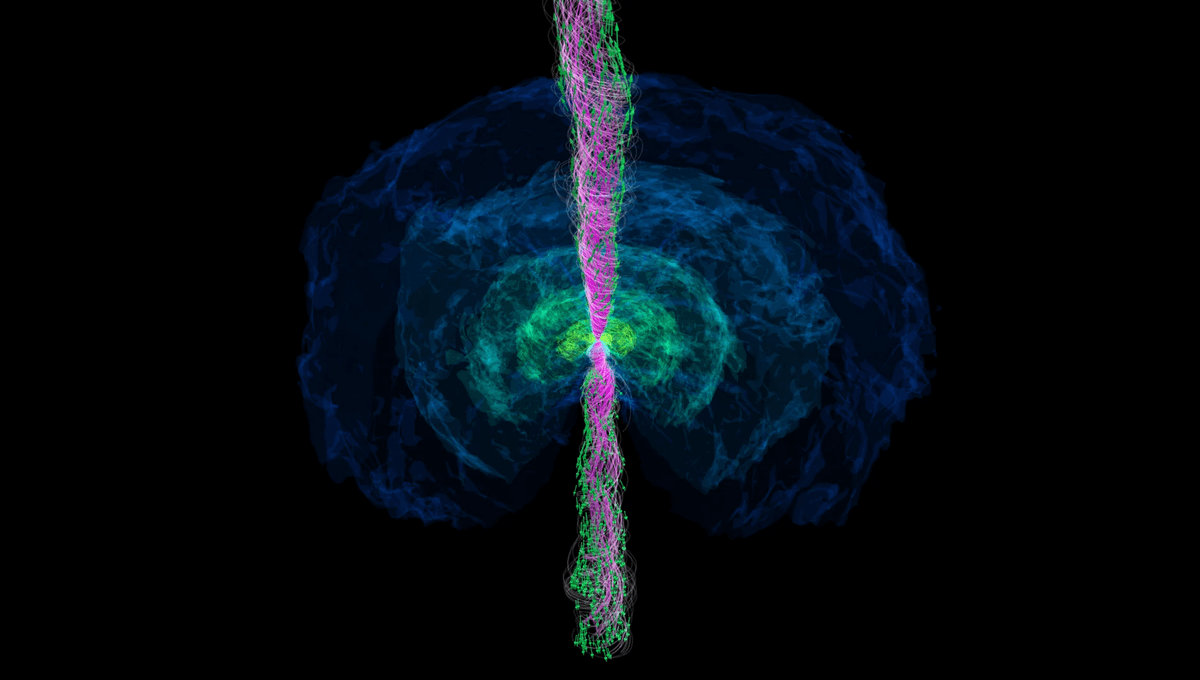Simulation Captures The Most Complex 1.5 Seconds In A Neutron Star Collision – And You Can Watch It Here

Simulation Captures The Most Complex 1.5 Seconds In A Neutron Star Collision – And You Can Watch It Here
Scientists have developed the longest and most complex simulation to date of a binary neutron star collision that results in the formation of a black hole and a jet. The breakthrough will massively improve future observations of these collisions, since they heavily rely on the theoretical backing to be discovered.
The first observation of gravitational waves from colliding neutron stars was a pivotal point in astronomy, heralding the establishment of multi-messenger astronomy. This means we study the universe not just with light anymore but also with gravitational waves and neutrinos (which, to be fair, we have done for a while longer). Neutron stars are the result of massive stars going supernova. These are extremely dense objects with extraordinary properties. A teaspoon of neutron star matter weighs like a mountain. The collision between neutron stars is a crucial multimessenger event because it emits gravitational waves, produces a gamma-ray burst, and also creates a lot of heavy chemical elements such as gold, platinum, and others. In that nuclear transformation, neutrinos (extremely light particles that interact very little with matter) escape into the universe. That is the simple picture, but simulating the crucial 1.5 seconds of chaos when all of that is happening requires some of our most advanced physics. Researchers used Einstein's theory of general relativity, neutrino emission, and the interaction of strong magnetic fields with the high-density matter inside the merging neutron stars (and this matter is defined as something called nuclear pasta). It took 130 million CPU hours to simulate those 1.5 seconds, using between 20,000 and 80,000 CPUs of the Fugaku supercomputer. The results are the most accurate simulation of these collisions yet. “Predicting the multi-messenger signals from binary neutron star mergers from first principles is extremely difficult. We have now succeeded in doing just that,” Kota Hayashi, a postdoctoral researcher in the Computational Relativistic Astrophysics department at the Max Planck Institute for Gravitational Physics, said in a statement. “Using the Fugaku supercomputer in Japan, we have performed the longest and most complex simulation of a binary neutron star merger to date.” The team simulated two neutron stars, one with a mass of 1.25 times our Sun and the other 1.65 times. In those 1.5 seconds, the neutron stars orbit each other five times, losing orbital energy in the form of gravitational waves. The collision makes the neutron star promptly collapse into a black hole as the object is too dense, releasing gravitational wave signals that we can detect with current observatories. The black hole is not the only thing that forms; matter from the collisions arranges itself into a disk around the black hole. The already intense magnetic fields of the neutron stars are enhanced by the fast spinning black hole, which accelerates the matter into a jet along the spinning axis. “We think that this energy flow along the black hole axis, driven by magnetic fields, powers a gamma-ray burst,” explained Masaru Shibata, director of the Computational Relativistic Astrophysics department. “This agrees with what we know from previous observations and provides further insight into the inner workings of neutron star mergers.” The simulation confirms the expected emission of neutrinos from these events, something yet to be detected, as well as the wider kilonova event, the formation of a cloud rich in heavy elements. “What we've learned about jet formation and magnetic field dynamics is crucial for our interpretation and understanding of neutron star mergers and their associated counterparts,” explained Masaru Shibata. A paper describing this work is published in Physical Review Letters.


